Dali
6 December 2005
The menu at the Sunshine Cafe in Dali excited me. It’s not that I don’t like Chinese food—I do. And I eat more than my share of it with real enthusiasm. Especially spicy pork dishes. But imagine going to your favorite Chinese restaurant every morning, noon and night for 4 months...
“I’ll have the tikka chicken,” I told the friendly waitress, with barely contained anticipation.
Ellen followed my lead, ordering an Indian mushroom dish, and Bei went enthusiastically for macaroni and cheese, all rare treats.
Fifteen minutes later my chicken arrived and the subtle meaning of “culture fatigue” seeped into my psyche, coloring the rest of my weekend the same muddy brown as the pitiful flakes of overcooked, under-flavored chicken which looked very small, lonely and un-tikka-like, hiding in a sea of lettuce. Crushed and hungry, I stared out the window of the cafe onto the stone street lined with small shops selling Chinese “antiques,” pirated CDs, Bob Marley posters and bus tickets to other tourist areas. And I thought to myself; “Dali sucks.”
But don’t let me get you down. Dali probably has some redeeming features. Just ask the zillions of Han Chinese tourists marching through the streets behind tour guides who wave their little tour flags while describing the scene through their megaphones. Or the young western travelers parked in front of computers surfing the Yahoo web sites and reading their e-mail. Or the touts that chase you as you dart from restaurant to hotel in a futile effort to avoid them.
The Lonely Planet travel guidebook (itself a blessing and a curse) describes Dali as:
Which begs the question: Why would you travel halfway around the world at considerable expense to “tune out” and “take a vacation from traveling?” And why didn’t this question occur to me before we headed south for a three hour trip on a local bus last Friday?
Despite my ranting cynicism, even in its most tourist-riddled places China is interesting, and we did have pleasurable moments in Dali. But this is not a place that I would move very high on your list of must-sees. Head north instead—to Lijiang or Zhongdian or Deqin, all touristy but all somehow more real, and stop in Dali only to grab lunch on your way past. But don’t order the tikka chicken.
San Ta Si (the three pagodas) are perhaps the most famous features in Dali. The tallest was built in the middle of the 9th century. I woke up before dawn on Saturday morning to walk 2 km to the site in hopes of capturing a peaceful sunrise. Instead I found tour buses pouring into a large parking area and disgorging tour groups. With some reservation, I paid the 52 yuan entry fee (why 52 yuan??!!) and joined the crowds as my plan evaporated. Despite the chaos, the towers were still compelling.

Another view of San Ta Si. Erhai Hu is the lake visible in the distance.
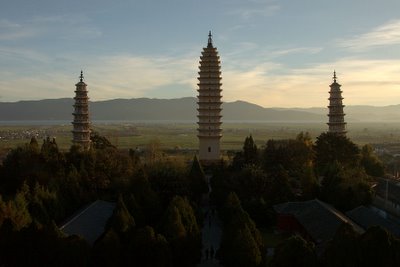
Handprints on the tallest of the 3 pagodas. Were these left by worshipers or by travelers trying to escape the tour groups?

Clouds over Dali at sunrise on a December morning.

Ellen and Bei were immediately captured by these funny and industrious Bai women who led them into their lair where they traded their goods for our money. One is demonstrating a traditional child carrier which Bei reports is very comfortable.

The town of Dali resembles a shopping mall installed in a construction zone. A short walk from the former in any direction leads to the latter, where dust and stone quarries rule the day. Dali is well known for its marble, which is quarried from the surrounding hills and cut with huge noisy saws into slabs and sellable knick knacks.

A storekeeper in the transition zone between the western tourist area and the construction zone.
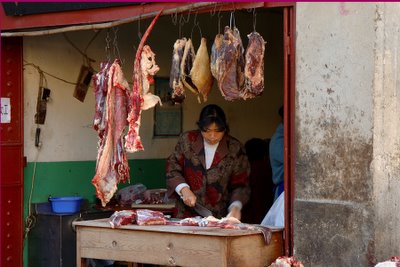
Our transport around Dali was accomplished on local buses, horse-drawn carriers and 3-wheeled motorcycles like this one that Bei enjoys just after it hauled us from the bus to the town of Xizhou where we spent an afternoon.

Xizhou is a Bai minority town on the shore of Erhai Hu. This scene is from a part of the village away from the main tourist market.

Xizhou appeared to be obsessed with fire. Murals like this one were found in many parts of town. The predominance of the English is inexplicable, since few people here speak it. At least we knew what to do if a fire were to break out (call 119!).

Hmmm. Could this explain some of the preoccupation with fire?

Street dentists are not uncommon in China and this practice was thriving in Dali on a Friday evening just before sunset. In their office against the stone gate on the north side of town, a dentist pecks away at a local tooth. Expertise and experience are obvious in the deftness with which he avoids burning the patient's eye with his cigarette. I wonder if he is on the Delta Dental preferred provider list?

Erhai Hu is a huge lake where fishing is reportedly part of the culture. But there is more money to be made taking tourists out for cormarant fishing demonstrations than in actually catching fish. We had hoped to see fishermen in action, but instead found only empty boats.
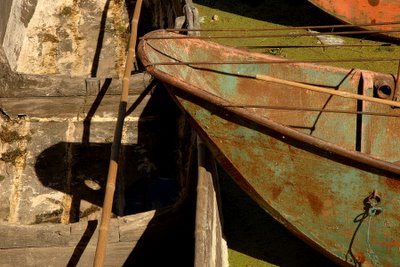
The view from Xizhou looking south towards Dali.
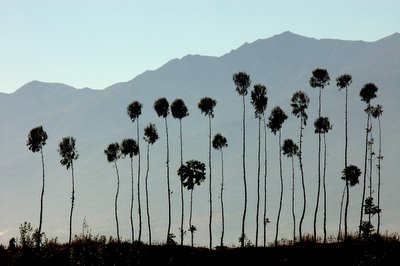
Hot chilis and a vendor's scale in the Xizhou market.
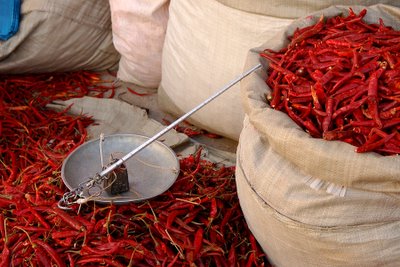
Spices for sale at Xizhou.

The people in Xizhou were friendly and the market there was fun to explore, though it folded up at noon for the afternoon rest. This man was delighted with his baby.

The Xizhou market.

A Bai woman in Xizhou. The Bai minority settled this region around 3000 years ago and today number about 1.5 million, according to the Lonely Planet guide.

More Bai women in the market. It's unusual to see women smoking in China, but in Xizhou the older women weren't bashful about it.

Nor were the local men, who smoke with vigour.
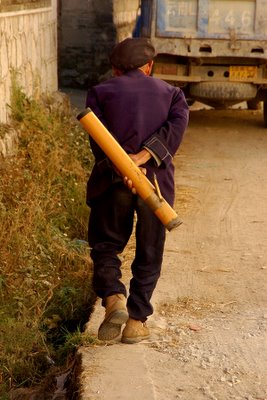
This 87 year old woman approached us in the main square at Xizhou selling little green seeds from a large tub. I purchased a small bag of them in the hope that she would then allow me to take her photo, but she refused, demanding an additional kuai (about 12 cents) for the privilege. Upon inspection, the seeds turned out to be pot, which is itself a well-advertised crop and tourist attraction in Dali.

The menu at the Sunshine Cafe in Dali excited me. It’s not that I don’t like Chinese food—I do. And I eat more than my share of it with real enthusiasm. Especially spicy pork dishes. But imagine going to your favorite Chinese restaurant every morning, noon and night for 4 months...
“I’ll have the tikka chicken,” I told the friendly waitress, with barely contained anticipation.
Ellen followed my lead, ordering an Indian mushroom dish, and Bei went enthusiastically for macaroni and cheese, all rare treats.
Fifteen minutes later my chicken arrived and the subtle meaning of “culture fatigue” seeped into my psyche, coloring the rest of my weekend the same muddy brown as the pitiful flakes of overcooked, under-flavored chicken which looked very small, lonely and un-tikka-like, hiding in a sea of lettuce. Crushed and hungry, I stared out the window of the cafe onto the stone street lined with small shops selling Chinese “antiques,” pirated CDs, Bob Marley posters and bus tickets to other tourist areas. And I thought to myself; “Dali sucks.”
But don’t let me get you down. Dali probably has some redeeming features. Just ask the zillions of Han Chinese tourists marching through the streets behind tour guides who wave their little tour flags while describing the scene through their megaphones. Or the young western travelers parked in front of computers surfing the Yahoo web sites and reading their e-mail. Or the touts that chase you as you dart from restaurant to hotel in a futile effort to avoid them.
The Lonely Planet travel guidebook (itself a blessing and a curse) describes Dali as:
“...a perfect place to tune out for a while and forget about trains, planes and bone-jarring buses. The stunning mountain backdrop, the lovely lake of Erhai Hu,the old city, the cappuccinos, pizzas and the herbal alternative to cheap Chinese beer make it, along with Yangshuo in Guangxi, one of the few places in China where you can well and truly take a vacation from traveling.”
Which begs the question: Why would you travel halfway around the world at considerable expense to “tune out” and “take a vacation from traveling?” And why didn’t this question occur to me before we headed south for a three hour trip on a local bus last Friday?
Despite my ranting cynicism, even in its most tourist-riddled places China is interesting, and we did have pleasurable moments in Dali. But this is not a place that I would move very high on your list of must-sees. Head north instead—to Lijiang or Zhongdian or Deqin, all touristy but all somehow more real, and stop in Dali only to grab lunch on your way past. But don’t order the tikka chicken.
San Ta Si (the three pagodas) are perhaps the most famous features in Dali. The tallest was built in the middle of the 9th century. I woke up before dawn on Saturday morning to walk 2 km to the site in hopes of capturing a peaceful sunrise. Instead I found tour buses pouring into a large parking area and disgorging tour groups. With some reservation, I paid the 52 yuan entry fee (why 52 yuan??!!) and joined the crowds as my plan evaporated. Despite the chaos, the towers were still compelling.

Another view of San Ta Si. Erhai Hu is the lake visible in the distance.

Handprints on the tallest of the 3 pagodas. Were these left by worshipers or by travelers trying to escape the tour groups?

Clouds over Dali at sunrise on a December morning.

Ellen and Bei were immediately captured by these funny and industrious Bai women who led them into their lair where they traded their goods for our money. One is demonstrating a traditional child carrier which Bei reports is very comfortable.

The town of Dali resembles a shopping mall installed in a construction zone. A short walk from the former in any direction leads to the latter, where dust and stone quarries rule the day. Dali is well known for its marble, which is quarried from the surrounding hills and cut with huge noisy saws into slabs and sellable knick knacks.

A storekeeper in the transition zone between the western tourist area and the construction zone.

Our transport around Dali was accomplished on local buses, horse-drawn carriers and 3-wheeled motorcycles like this one that Bei enjoys just after it hauled us from the bus to the town of Xizhou where we spent an afternoon.

Xizhou is a Bai minority town on the shore of Erhai Hu. This scene is from a part of the village away from the main tourist market.

Xizhou appeared to be obsessed with fire. Murals like this one were found in many parts of town. The predominance of the English is inexplicable, since few people here speak it. At least we knew what to do if a fire were to break out (call 119!).

Hmmm. Could this explain some of the preoccupation with fire?

Street dentists are not uncommon in China and this practice was thriving in Dali on a Friday evening just before sunset. In their office against the stone gate on the north side of town, a dentist pecks away at a local tooth. Expertise and experience are obvious in the deftness with which he avoids burning the patient's eye with his cigarette. I wonder if he is on the Delta Dental preferred provider list?

Erhai Hu is a huge lake where fishing is reportedly part of the culture. But there is more money to be made taking tourists out for cormarant fishing demonstrations than in actually catching fish. We had hoped to see fishermen in action, but instead found only empty boats.

The view from Xizhou looking south towards Dali.

Hot chilis and a vendor's scale in the Xizhou market.

Spices for sale at Xizhou.

The people in Xizhou were friendly and the market there was fun to explore, though it folded up at noon for the afternoon rest. This man was delighted with his baby.

The Xizhou market.

A Bai woman in Xizhou. The Bai minority settled this region around 3000 years ago and today number about 1.5 million, according to the Lonely Planet guide.

More Bai women in the market. It's unusual to see women smoking in China, but in Xizhou the older women weren't bashful about it.

Nor were the local men, who smoke with vigour.

This 87 year old woman approached us in the main square at Xizhou selling little green seeds from a large tub. I purchased a small bag of them in the hope that she would then allow me to take her photo, but she refused, demanding an additional kuai (about 12 cents) for the privilege. Upon inspection, the seeds turned out to be pot, which is itself a well-advertised crop and tourist attraction in Dali.


0 Comments:
Post a Comment
<< Home